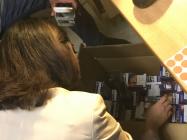Unlocking Our Sound Heritage - Digitisation
Items in this story:
This story will have images of students from the Aberystwyth University who are studying an MA in Archive Administration carrying out the process of digitsation for The Story of Forest Project, which is a part of the Unlocking our Sound Heritage Project.
The hands-on digitization portion of the Story of the Forest project begins with the process of transferring audio recordings from their original medium (audiotapes) to its current physical form, Minidiscs. At current this collection is being maintained inside the National Library. Minidiscs are prepared to be stored in the National Library by means of shelve numbers which are also linked to digital records that are used by everyone who is working towards the project’s completion. This link allows access to the shelved media and acts as a reference in cases of data loss or transfer errors.
The digitalization process can be summarized into five steps:
1. Transferring voice interviews from the original audio tapes to the minidiscs (allocating one mini disk for one interview). Usually, there is more than one record for one interview.
2. In this step, using a windows Vista, the minidiscs files are copied from the minidisc into a program known as Sonic Stage and saved as individual wave files.
3. Using Wave Lab Pro files are then spliced together to make one audio track and saved as a single file.
4. The single wave file is then converted to MP4 through Wave Lab Pro and then is sent off for use by those who are working on transcriptions and cataloging and description.
5. One of the most important steps in this process is the checksum which is algorithm program that scans the newly converted audio files to check if there are any digital errors in the record before sending them on to other processes. It is worth noting that each stage of the digitization process, the record files are saved in separate units to facilitate the process of tracking steps and fixing errors.
The process of completing the digitization portion of the Story of the Forest project can be broken down into being a very rewarding and an informative hand on experience. At the beginning the task seemed daunting between understanding the scope of how many minidiscs there were that needed to be digitized to actually beginning the process of converting the discs. Thanks to the classes dedication with nearly everyone coming in to help with the work the digitization of the minidiscs was completed before schedule. As with any project there will be small road blocks, such as having to restart the digitization process after losing your place during the splicing phase. Or larger road blocks that come with the territory of having to deal with older fussy equipment where only after tapping the machine would it decide to co-operate. Having problems such as these help in the learning experience.




